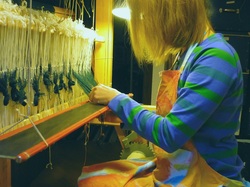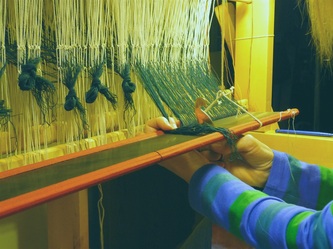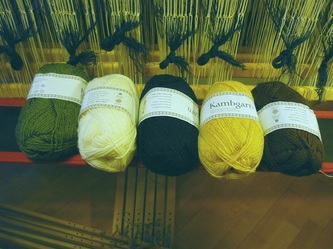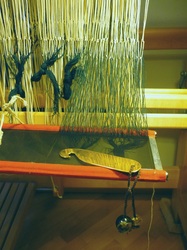 I spent a day sleying. I am learning new English words and sleying is a new word for me but the process i have known for long. I know the weaving terms best in Swedish. Sleying means to draw threads through the reed with a reed hook ( see post 26/10/2012) . The threads that I was sleying are together forming the warp that is in the loom at present. Dark blue as you can see from the images. The reed sits in the batten and is used to keep the threads in their position a certain number of threads per width and also is used to beat the weft into the warp. Also you can see the heddles on the pictures. The warp is also threaded through heddles. I am going to weave woolen cloth that will be turned into cushions, you can also see the balls of wool that will be used for this project. Not a rag rug this time. I very seldom weave anything else but rag rugs. This is one of the rare other pieces. Words for the Icelanders: Sleying = draga í skeið. Reed = skeið. Warp = uppistaða. Heddles = haföld. The process of preparing a the warp takes time, is slow and fun (I think). A friend was photographing me while I was threading the heddles. If I am lucky I can show you some of those images here. I am listening to an audio book by the Swedish author Jan Guillout "Brobyggarna" = Bridge builders, with all this work and having a splendid time. A book, an adventure, that takes place in early 20th century.
3 Comments
Marled
10/1/2013 04:24:19
Here comes the german translation: draga í skeið = einziehen oder Blattstich (a noun), skeið = Blatt oder Ried, uppistaða = Kette, haföld = Litzen. The words seem not comparable like other. That means for me, weaving was so important and individual, that each country developped its own vocabulary.
Reply
anna maria
10/1/2013 13:50:21
Great. Thank you Marled. Are you a weaver too? Well, Ried seems like the English reed. But as you say they seem to have developed individually in each country or culture. And of course some of the words are very ancient and you need to be a linguist or something to figure them out. What I also find interesting is how much of weaver's vocabulary is still in the language ( icelandic ) and used in different meanings. E.g. rekja = schären, warping, used now in the term of tracing or tracking. Like you trace the yarn while warping. There is more. Is there anything similar in German?
Reply
Marled
11/1/2013 03:57:59
Yes, I'm a weaver too, mainly for historic textiles. and yes, there are a lot of weaving related words which you may find with another meaning in dailys talk too like Schuss = weft, Schaft = shaft, Leinwand = tabby and so on. Very interesting!
Reply
Leave a Reply. |
AuthorAnna María Lind, MA Textile Art Winchester School of Art. Archives
June 2024
|






 RSS Feed
RSS Feed